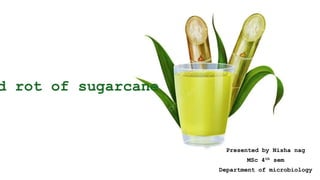
Red rot of sugarcane and there causes by clostridium falcatum virus.
- 1. d rot of sugarcane Presented by Nisha nag MSc 4th sem Department of microbiology
- 2. Content:- 1.Introduction 2.History 3.Casual organism 4.Pathogen character 5.Etiology 6.transmission 7.Disease cycle 8.Symptoms 9.Survival and spread 10.Favorable conditions 11.Disease management 12.Integrated disease management 13.Reference
- 3. Introduction Red rot is one of the major constraints in the profitable cultivation of sugarcane in many states of India. • Except Maharashtra the disease has been recorded in all the state. • This disease drastically retards the yield and considerably deteriorates the juice quantity and quality thus hitting both the cane growers and millers
- 4. History:- • First reported in 1893 from Java (Indonesia). • In India first reported in 1901 in Andhra Pradesh. • Disease epidemic occured in 1939-1940 in UP & BIHAR. • Disease is soil and seed borne. • This accepted name, ‘Red rot’ was given to this cane disease in 1906 by sir E.J Butler.
- 5. Casual organism:- Kingdom :- fungi Phylum :- Ascomycota Class :- sordariomcetes Order :- phyllachorales Family :- Glomerellaceae Genus :- Colletotrichum Species :- falcatum
- 6. Pathogen Character:- 1.Anamorph :- colletotrichum fakatum 2.Teleomorph :- Glomerella tacumanensis. Etiology :- Caused by collectotrichum falcatum, a facultative saprophyte. • Sexual stage known as Glomerella tucumanensis. • Mycellium:- both intracellular and intercellular. • Asexual fruiting bodies known as Acervuli. • Conidiophores:- linear or club shaped, hyallne,septate. • Conidia:- elongated,single celled, thin walled, uninucleate, colourless, sickle shaped (falcate) with granuar protoplasm with a large oil globule.
- 8. Transmission:- • Primary transmission through soil and disease sets while the secondary transmission through air, rain splash and soil.
- 9. Disease cycle:- • The fungus is sett born. • The fungus also persist in the soil on the disease clumps and stubble as acervulli. • The primary infection is mainly from infected setts. • Secondary spread in the field maybe through irrigation water and cultivation tools. • The rain splash air currents and dew drops also help in the spread of conidia from the disease to healthy plant in the field. • The fungus also survives on collateral host like Sorghum vulgare, S. Haleperse and saccharum spontaneum.
- 11. Symptoms:- Two types of symptoms:- 1.Stalk symptoms 2.leaf symptoms
- 12. Stalk symptoms:- .The first symptom seen after the rainy season when the normal plant growth stops and sucrose formation was started. • Loose of colour and dropping of third or fourth leaves from the top are the early symptoms the intert weakness withers. • In letter States the canes become shriveled the red shrinks and become longitudinally wrinkled. Such canes are lighter invade and easily broken. • If the disease canes are split open longitudinally, especially when withering of leaves started the pic took red
- 13. Continue- • In very advance stage, red colour maybe replaced by dirty brown cavities filled with Greyish mycelium and the juice gives a bad smell due to conversion of sucrose into glucose and alcohol as a result of enzymetic action of pathogen.
- 14. Leaf symptoms:- • Tini reddish lesion of the upper surface of lamina these lesions are 2 to 3 mm in length and about 0.5 mm in width. • Menu trade rot on upper surface of midrib of leaf later on become straw coloured in centre with development of darker acervuli.
- 15. Survival and spread:- • They reply heavily on water, particularly rainfall, for dissemination. • The fungus is sett borne and also perists in the soil on the diseased clumps and stubbles. • Spread Of the fungus occurs in Planting material, and this can be over both short and long distance. • Spread also occurs as spore produced on infected plants, water – splashed to those nearby. • The fungus can survive for a few months in the soil on plant debris & in sugarcane stems.
- 16. Favorable conditions:- • Successive raton cropping • Water logged conditions and injuries caused by insects. • Mean temperature range from 29.4 to 31 degree c for disease development. • pH 5-6. • Drought condition during the initial growth is favorable. • High humidity. • Water logged condition of the soil.
- 17. Disease management:- • Use always disease free setts. • Hot water treatment- 52°c for 8hrs 54°c for 2hrs. • Hot air treatment- 54°c for 6 hrs. • Removal of infected stools . • Crop rotation 2-3 yrs. • Use disease res.varaties- cos-767,co-840,co- 1148,co-1158, Bo-32, co-975,1148,1158,1336 & 6611, co-5-561,544,B.O-3,10,47.
- 19. Reference:- • Bagyraj and Rangasamy. • Slideshare • Biology notes • https://agritech.tnau.ac.in/crop_protection/sug arcane_diseases/sugarcane_d4.html